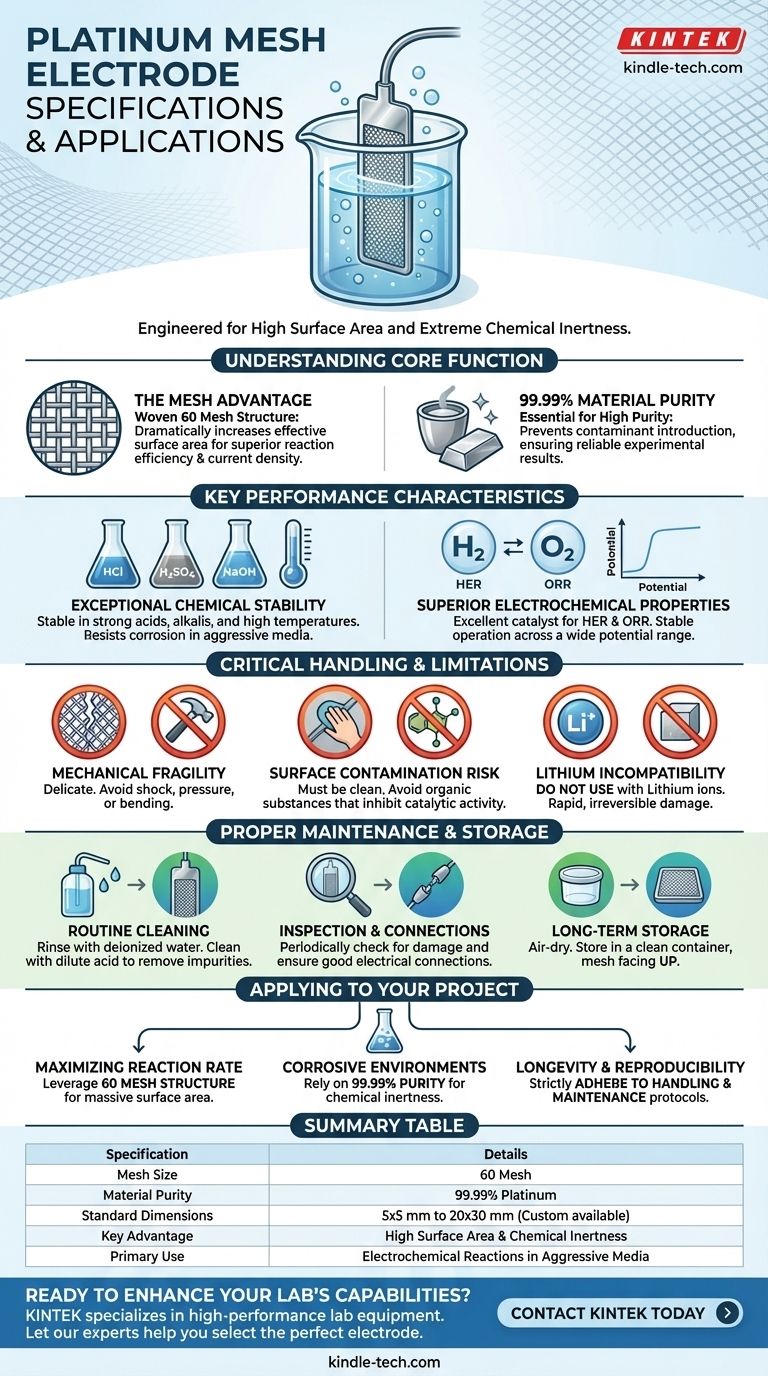A standard platinum mesh electrode is defined by a 60 mesh size, is constructed from 99.99% pure platinum wire, and is available in a range of standard dimensions from 5x5 mm to 20x30 mm. Custom sizing is also typically available to meet specific experimental requirements.
The core value of a platinum mesh electrode lies in its unique combination of an exceptionally high surface area-to-volume ratio and platinum's inherent chemical inertness. This makes it an ideal choice for maximizing reaction rates in aggressive electrochemical environments.

Understanding the Electrode's Core Function
The Advantage of the Mesh Structure
A platinum mesh electrode is created by weaving high-purity platinum wire into a grid. This mesh design is a critical engineering choice.
Unlike a solid sheet, the woven structure dramatically increases the effective surface area available for electrochemical reactions. This directly enhances reaction efficiency and current density for processes like electrolysis.
Material Purity and Its Impact
These electrodes are made from 99.99% pure platinum. This high level of purity is essential for scientific and industrial applications.
It ensures that the electrode itself does not introduce contaminants into the experiment, guaranteeing that the observed results are due to the intended reaction and not from metallic impurities.
Key Performance Characteristics
Exceptional Chemical Stability
Platinum is renowned for its stability in strong acids, strong alkalis, and at high temperatures. It shows exceptional resistance to corrosion from common aggressive media like hydrochloric, sulfuric, and nitric acid.
This inertness allows the electrode to operate for extended periods in harsh electrolytes without degrading, ensuring both longevity and experimental consistency.
Superior Electrochemical Properties
Platinum serves as an excellent catalyst for many electrochemical reactions, including the hydrogen evolution reaction (HER) and oxygen reduction reaction (ORR).
It can operate stably across a wide potential range, making it a versatile and reliable choice for a broad spectrum of electrochemical research and analysis.
Critical Handling and Limitations
Mechanical Fragility
The platinum mesh is soft and delicate. It is crucial to avoid mechanical shock, pressure, or bending, as this can easily damage the mesh structure and compromise its performance. Always handle it gently.
Risk of Surface Contamination
The electrode's performance is highly dependent on a clean surface. Avoid contact with organic substances or other materials that can "foul" or coat the surface, which would inhibit its catalytic activity.
Specific Chemical Incompatibilities
Crucially, platinum mesh electrodes must not be used in the presence of lithium ions. Lithium is corrosive to platinum and will cause rapid, irreversible damage to the electrode.
Proper Maintenance and Storage
Routine Cleaning Procedures
After use, immediately rinse the electrode with deionized water to remove any residual electrolyte.
To remove surface oxides or stubborn impurities, you can carefully clean the electrode in a dilute acid solution.
Inspection and Connections
Periodically inspect the electrode for any signs of damage. It is also important to check the wire connections to the power source to ensure good electrical conductivity is maintained.
Long-Term Storage
After cleaning, the electrode should be air-dried or placed in a low-temperature oven. Store the dried electrode in a clean, dry, non-contaminating container.
To protect the most delicate part, always store it with the connection point facing down and the platinum mesh facing upwards.
How to Apply This to Your Project
Here is how to align the electrode's properties with your primary objective:
- If your primary focus is maximizing reaction rate: The 60 mesh structure provides a massive surface area, making it superior to a flat sheet electrode for achieving high current density and efficiency.
- If your primary focus is working in corrosive environments: The 99.99% pure platinum offers the chemical inertness needed to withstand strong acids and bases without degrading.
- If your primary focus is experiment longevity and reproducibility: Adhering strictly to the handling, cleaning, and storage protocols is non-negotiable for ensuring reliable performance over time.
Understanding these specifications and operational principles is key to leveraging the full potential of your platinum mesh electrode.
Summary Table:
| Specification | Details |
|---|---|
| Mesh Size | 60 Mesh |
| Material Purity | 99.99% Platinum |
| Standard Dimensions | 5x5 mm to 20x30 mm |
| Key Advantage | High surface area & chemical inertness |
| Primary Use | Electrochemical reactions in aggressive media |
Ready to enhance your lab's electrochemical capabilities?
At KINTEK, we specialize in providing high-performance lab equipment and consumables, including precision platinum mesh electrodes. Our products are designed to deliver the reliability and purity your research demands.
Let our experts help you select the perfect electrode for your specific application, ensuring maximum reaction efficiency and longevity.
Contact us today to discuss your project needs and discover the KINTEK difference!
Visual Guide

Related Products
- Platinum Sheet Electrode for Laboratory and Industrial Applications
- Rotating Platinum Disk Electrode for Electrochemical Applications
- Platinum Auxiliary Electrode for Laboratory Use
- Metal Disc Electrode Electrochemical Electrode
- Gold Disc Electrode
People Also Ask
- What is the most critical guideline for immersing a platinum sheet electrode in an electrolyte? Ensure Accurate Electrochemical Measurements
- What are the performance characteristics of platinum sheet electrodes? Unlock Superior Electrochemical Performance
- What is the proper post-treatment procedure for a platinum sheet electrode? Ensure Long-Term Accuracy & Protect Your Investment
- How should a platinum sheet electrode be pretreated before use? Ensure Accurate Electrochemical Measurements
- What are the available specifications for platinum sheet electrodes? Find the Perfect Fit for Your Electrochemical Needs



















